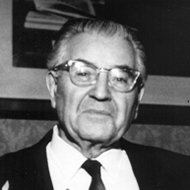Karel Boleslav Jirak ranks among the leading representatives of modern Czech music even though he left Czechoslovakia in 1947 to take up a teaching post in the USA (Chicago Musical College of Roosevelt University), where he settled down for the rest of his life (1947- 1969).
Jirak was an exceptionally versatile personality ever since his youth. After graduating from a law faculty in 1913, he devoted himself entirely to composing and organizing the country\'s musical life. He was not only a brilliant composer but also an accomplished pedagogue (among his pupils at the Conservatoire in Prague were Jaroslav Jezek, Isa Krejci, Miloslav Kabelac, Klement Slavicky, and Frantisek Bartos). His private pupils were Svatopluk Havelka and Frantisek Kovaricek who both later became well-known composers and teachers. K.B.Jirak was also very succesful as a conductor and choirmaster (for a time he was the second conductor of the Czech Philharmonic and a frequent guest conducting many Czechoslovak and foreign symphony orchestras), organizer of musical life (he was a high-ranking official of the International Society for Contemporary Music) as well as a publicist (penning some 1,000 music reviews and specialized articles published in daily newspapers and musical journals alike). Between 1930 and 1945 Jirak was the director of the Czechoslovak Radio\'s musical broadcasting department.
Although his music teachers in composition included such experienced and distinguished pedagogues as Vitezslav Novak and Josef Bohuslav Foerster, Jirak never received a comprehensive classical training in composition. Having composed some of his early works, which were incidentally steeped in a Smetanean and Fibichian tradition, Jirak assumed the role of a leading avantgarde composer whose chief models were Otakar Ostrcil and Gustav Mahler and Richard Strauss in instrumentation. Even though some of Jirak\'s works created during the First World War [namely the First String Quartet, op. 9, Thirteen Simple Songs, op.13, or the String Sextet with Alto Solo op.14] betray Mahler\'s influence, their other qualities safely point to the composer\'s intimate knowledge of the key composition principles of Schonberg. And yet Jirak did not succeed in breaking out of the late romantic tradition in his musical feeling, a fact corroborated by his subsequent works from the postwar years, notably Three Songs of Home to texts by A. Sova, op.18, Psalm No. 23 to the words of the Kralice Bible for Mixed Choir and Orchestra, op.19, Overture to a Shakespearean comedy, op. 22, and especially his Second Symphony in F-major, op.25. In his piano cycle entitled At the Boundary, composed in 1923, Jirak - acting under the impact of the prevailing trends in contemporary international music - attempted to resolve the problem of his stylistic orientation. Try as he might, he still failed to break with traditions, with all that had been dear to his musical disposition. In his subsequent compositions (eg. the Piano Sonata, op. 30, Divertimento for Violin, Viola and Violoncello, op.28, the Second String Quartet, op. 31, the Wind Quintet, op. 34, or in the cycles of songs called Awakening and Rainbow, op.27 and 29 respectively) Jirak set out to highlight the principle of formal conciseness in terms of tectonics and to harmonize the sensual and reflexive components of his creative process. All the time he was well aware of the vicious circle in which modern music of the 1920s was imprisoned and that may have been the main reason why in the following decade Jirak did not write a single composition. After that self-imposed pause he re-entered the musical scene with several major works, particularly the Third Symphony, op. 37, and Symphonic [originally Philharmonic] Variations, op. 40.
Even after his arrival in the United States Jirak changed nothing in his style of composition, essentially remaining to be a profound and convinced lyricist. Although that late romantic disposition still dominated his musical nature, shaping the works created in the new environment, his thorough knowledge of prevailing trends in modern music enabled him to modify his composition technique which - though not precisely ground-breaking or pioneering, rationalistically constructivist or highlighting a single contemporary method - might still be described as neither ecletic nor conservative. Some of the major compositions from Jirak s American period are his Fifth and Sixth Symphonies, op. 60 and 90 respectively, four String Quartets, op. 63, 67, 80, and 82, the Second Piano Sonata, op. 64, the Requiem for Soli, Mixed Choir and Orchestra, op. 70, and a number of vocal, instrumental, chamber and concertante works.
All in all, Jirak himself selected from his extensive corpus of compositions a total of 94 works, comprising one opera, 14 cycles of songs, 11 choral compositions, 6 symphonies, 9 orchestral and 11 vocal-orchestral works, 6 concertante compositions,14 pieces for chamber ensembles (trios, quartets, quintets, one sextet and nonet each),12 piano compositions and 21 works for solo instruments (some of them with piano accompaniment) etc. The most widely read among Karel Boleslav Jirak\'s theoretical studies is The Theory of Musical Forms, a book which has so far seen six revised editions and which has also been published abroad.

